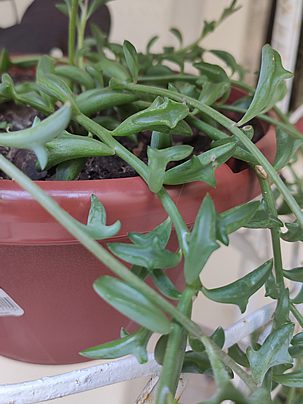A delicate succulent, the Dolphin Necklace enchants children and adults with its characteristic leaves that resemble dolphins leaping over the waves. Although many sources consider the dolphin necklace as a species, Senecio peregrinus, it is actually a hybrid, and the correct name is Senecio ‘Hippogriff.’ It results from the hybridization between the string of pearls (Senecio rowleyanus) and the candle plant (Senecio articulatus). The parents of this beautiful hybrid originate from the south and southwest of Africa, so we can consider its habitat in a similar way.
In height, the dolphin necklace does not exceed 6 inches (15 centimeters), but when cultivated as a hanging plant, its branches can easily reach up to 3 feet (approximately 1 meter) in length. Its foliage is very characteristic, ranging from light green to slightly grayish, and it takes the shape of dolphins, which act as windows that allow maximum light entry while reducing excess transpiration at the same time, like many succulent species with partially transparent leaves.
Under conditions of higher brightness, preferably with direct sunlight for a few hours a day, the plant appears denser in leaves, whereas under diffused light, it presents more spaced leaves that may eventually open, losing the dolphin shape and acquiring the form of small stingrays. The trailing and thin branches are similar to those of the string of pearls, being delicate and easy to break with mechanical traction. It blooms in autumn and winter, producing delicate inflorescences composed of white flowers that form small clusters with a cinnamon fragrance.
The dolphin necklace can be used as ground cover, but its curious foliage is more valued in pots, baskets, or hanging planters, allowing its delicate branches with leaping dolphins to be appreciated up close on balconies or naturally well-lit indoor spaces. Cultivated alone or in compositions with other succulents, it invariably causes astonishment and admiration among its viewers.

It should be cultivated in partial shade or abundant filtered light, with perfectly well-draining soil and spaced watering. The ideal lighting conditions for the species include ample indirect light throughout the day, with some hours of direct sunlight in the morning. The hot midday and afternoon sun can cause leaf burns. Like other succulents, the dolphin necklace appreciates its substrate drying out between waterings, but it can contain a bit more organic matter than usual for succulents since it enjoys a bit more moisture.
However, be cautious as the dolphin necklace is equally sensitive to overwatering and consequent reduction in substrate aeration, leading to root rot and plant death. During winter, it’s essential to reduce watering, keeping the substrate slightly drier. It does not tolerate frost or severe cold and should be brought indoors during harsh winters. It is tolerant of short periods of drought.
Obtain dense pots by layering the branches, thereby stimulating root formation at various points on the stem. Pruning the tips of the branches is also interesting since it promotes the breaking of apical dominance and stimulates plant branching. It multiplies easily by stem cuttings, which are placed to root in the substrate or in water, or by layering, attaching branches with clips to the substrate to create new roots in contact with the soil. After the segments have rooted, which can take two to three weeks, we can separate the offspring from the mother plant and plant them in their final location.

